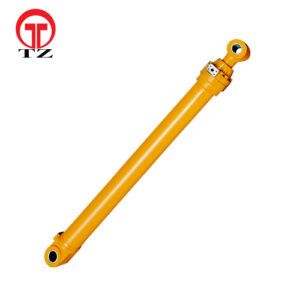The specifications of hydraulic cylinders for excavators can vary depending on the specific model and manufacturer, but some common specifications include:
- Bore diameter: The bore diameter of a hydraulic cylinder refers to the diameter of the cylinder’s piston. This is typically measured in millimeters (mm) or inches (in), and can range from around 50mm to 250mm or more, depending on the size of the excavator.
- Stroke length: The stroke length of a hydraulic cylinder refers to the distance that the piston can travel inside the cylinder. This is typically measured in millimeters or inches, and can range from around 200mm to 1200mm or more, depending on the excavator’s needs.
- Working pressure: The working pressure of a hydraulic cylinder refers to the maximum amount of pressure that the cylinder can withstand while in use. This is typically measured in bars or pounds per square inch (psi), and can range from around 250 bars to 400 bars or more, depending on the requirements of the excavator.
- Mounting style: The mounting style of a hydraulic cylinder refers to the way in which the cylinder is attached to the excavator’s frame or other components. Common mounting styles include clevis, flange, and trunnion mounts.
- Rod diameter: The rod diameter of a hydraulic cylinder refers to the diameter of the cylinder’s piston rod. This is typically smaller than the bore diameter, and can range from around 30mm to 100mm or more, depending on the size of the cylinder.
- Seal type: The seal type of a hydraulic cylinder refers to the type of seal used to prevent hydraulic fluid from leaking out of the cylinder. Common seal types include piston seals, rod seals, and wiper seals.
- Material: The material used to make hydraulic cylinders for excavators can vary depending on the manufacturer and the intended application. Common materials include steel, aluminum, and various alloys.
It’s important to note that these are just some of the most common specifications for hydraulic cylinders used in excavators. The specific requirements may vary depending on the application, and it’s always a good idea to consult with the manufacturer or an experienced engineer to determine the best cylinder for a particular excavator.
What is hydraulic cylinder for excavator and How Does it Work?
A hydraulic cylinder for excavator is a mechanical actuator used to generate linear motion and force through the use of hydraulic fluid under pressure. The cylinder is commonly used in excavators to power various hydraulic attachments such as buckets, booms, and arms.
The basic structure of a hydraulic cylinder for excavator includes a cylinder barrel, a piston and piston rod, seals, and end caps. hydraulic cylinder for excavator The cylinder barrel is a long, hollow tube that provides the space for the piston and hydraulic fluid. The piston is a round disc-shaped component that fits tightly within the cylinder barrel and is connected to the piston rod, which extends from one end of the cylinder.
When hydraulic fluid is pumped into the cylinder barrel, it flows through the hydraulic ports and exerts pressure on the piston, causing it to move along the length of the cylinder. This movement of the piston is transferred to the piston rod, which extends or retracts to move the attachment connected to the cylinder.
The hydraulic fluid is typically supplied from a hydraulic pump, which is powered by the excavator’s engine. The pump pushes the fluid through the hydraulic lines and into the cylinder, creating the necessary pressure to move the piston and piston rod. To control the movement of the cylinder and the attachment, the excavator operator can adjust the amount of hydraulic fluid flowing into the cylinder, as well as the pressure of the fluid.
Overall, hydraulic cylinders for excavators provide a reliable and efficient method for generating linear motion and force in a wide range of excavator applications, making them an essential component of modern excavation equipment.
